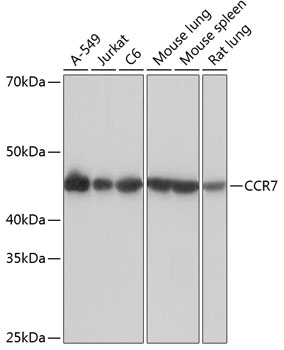Cell Biology Antibodies 16
Anti-CCR7 Antibody (CAB0121)
- SKU:
- CAB0121
- Product Type:
- Antibody
- Reactivity:
- Human
- Reactivity:
- Mouse
- Reactivity:
- Rat
- Host Species:
- Rabbit
- Isotype:
- IgG
- Antibody Type:
- Monoclonal Antibody
- Research Area:
- Cell Biology
Description
| Antibody Name: | Anti-CCR7 Antibody |
| Antibody SKU: | CAB0121 |
| Antibody Size: | 20uL, 50uL, 100uL |
| Application: | WB IHC IF |
| Reactivity: | Human, Mouse, Rat |
| Host Species: | Rabbit |
| Immunogen: | A synthesized peptide derived from human CCR7 |
| Application: | WB IHC IF |
| Recommended Dilution: | WB 1:500 - 1:2000 IHC 1:50 - 1:200 IF 1:50 - 1:200 |
| Reactivity: | Human, Mouse, Rat |
| Positive Samples: | A-549, Jurkat, C6, Mouse lung, Mouse spleen, Rat lung |
| Immunogen: | A synthesized peptide derived from human CCR7 |
| Purification Method: | Affinity purification |
| Storage Buffer: | Store at -20°C. Avoid freeze / thaw cycles. Buffer: PBS with 0.02% sodium azide, 0.05% BSA, 50% glycerol, pH7.3. |
| Isotype: | IgG |
| Sequence: | Email for sequence |
| Gene ID: | 1236 |
| Uniprot: | P32248 |
| Cellular Location: | Cell membrane, Multi-pass membrane protein |
| Calculated MW: | 43kDa |
| Observed MW: | 43KDa |
| Synonyms: | BLR2, CC-CKR-7, CCR-7, CD197, CDw197, CMKBR7, EBI1 |
| Background: | The protein encoded by this gene is a member of the G protein-coupled receptor family. This receptor was identified as a gene induced by the Epstein-Barr virus (EBV), and is thought to be a mediator of EBV effects on B lymphocytes. This receptor is expressed in various lymphoid tissues and activates B and T lymphocytes. It has been shown to control the migration of memory T cells to inflamed tissues, as well as stimulate dendritic cell maturation. The chemokine (C-C motif) ligand 19 (CCL19/ECL) has been reported to be a specific ligand of this receptor. Signals mediated by this receptor regulate T cell homeostasis in lymph nodes, and may also function in the activation and polarization of T cells, and in chronic inflammation pathogenesis. Alternative splicing of this gene results in multiple transcript variants. [provided by RefSeq, Sep 2014] |
| UniProt Protein Function: | CCR7: Receptor for the MIP-3-beta chemokine. Probable mediator of EBV effects on B-lymphocytes or of normal lymphocyte functions. Belongs to the G-protein coupled receptor 1 family. |
| UniProt Protein Details: | Protein type:Motility/polarity/chemotaxis; GPCR, family 1; Membrane protein, multi-pass; Receptor, GPCR; Membrane protein, integral Chromosomal Location of Human Ortholog: 17q12-q21.2 Cellular Component: cell surface; plasma membrane; integral to membrane; intracellular; external side of plasma membrane Molecular Function:G-protein coupled receptor activity; C-C chemokine receptor activity Biological Process: positive regulation of cell adhesion; positive regulation of interleukin-12 production; positive regulation of dendritic cell antigen processing and presentation; positive regulation of JNK cascade; response to lipopolysaccharide; elevation of cytosolic calcium ion concentration; positive regulation of T cell receptor signaling pathway; positive regulation of humoral immune response; dendritic cell chemotaxis; establishment of T cell polarity; positive regulation of cell-matrix adhesion; inflammatory response; positive regulation of filopodium formation; positive regulation of I-kappaB kinase/NF-kappaB cascade; positive regulation of hypersensitivity; positive regulation of phosphoinositide 3-kinase activity; negative thymic T cell selection; positive regulation of protein kinase B signaling cascade; G-protein coupled receptor protein signaling pathway; myeloid dendritic cell chemotaxis; positive regulation of pseudopodium formation; positive regulation of actin filament polymerization; regulation of interferon-gamma production; release of sequestered calcium ion into cytosol; positive regulation of protein kinase activity; ruffle organization and biogenesis; regulation of interleukin-1 beta secretion; immune response |
| NCBI Summary: | The protein encoded by this gene is a member of the G protein-coupled receptor family. This receptor was identified as a gene induced by the Epstein-Barr virus (EBV), and is thought to be a mediator of EBV effects on B lymphocytes. This receptor is expressed in various lymphoid tissues and activates B and T lymphocytes. It has been shown to control the migration of memory T cells to inflamed tissues, as well as stimulate dendritic cell maturation. The chemokine (C-C motif) ligand 19 (CCL19/ECL) has been reported to be a specific ligand of this receptor. Signals mediated by this receptor regulate T cell homeostasis in lymph nodes, and may also function in the activation and polarization of T cells, and in chronic inflammation pathogenesis. Alternative splicing of this gene results in multiple transcript variants. [provided by RefSeq, Sep 2014] |
| UniProt Code: | P32248 |
| NCBI GenInfo Identifier: | 1352335 |
| NCBI Gene ID: | 1236 |
| NCBI Accession: | P32248.2 |
| UniProt Related Accession: | P32248 |
| Molecular Weight: | 378 |
| NCBI Full Name: | C-C chemokine receptor type 7 |
| NCBI Synonym Full Names: | chemokine (C-C motif) receptor 7 |
| NCBI Official Symbol: | CCR7 |
| NCBI Official Synonym Symbols: | BLR2; EBI1; CCR-7; CD197; CDw197; CMKBR7; CC-CKR-7 |
| NCBI Protein Information: | C-C chemokine receptor type 7; MIP-3 beta receptor; CC chemokine receptor 7; Bukitt's lymphoma receptor 2; Epstein-Barr virus induced gene 1; EBV-induced G protein-coupled receptor 1; lymphocyte-specific G protein-coupled peptide receptor; Epstein-Barr virus-induced G-protein coupled receptor 1 |
| UniProt Protein Name: | C-C chemokine receptor type 7 |
| UniProt Synonym Protein Names: | BLR2; CDw197; Epstein-Barr virus-induced G-protein coupled receptor 1; EBI1; EBV-induced G-protein coupled receptor 1; MIP-3 beta receptor; CD_antigen: CD197 |
| Protein Family: | C-C chemokine receptor |
| UniProt Gene Name: | CCR7 |
| UniProt Entry Name: | CCR7_HUMAN |




![GenieFluor Violet 450 Anti-Human CD197/CCR7 Antibody [G043H7] GenieFluor Violet 450 Anti-Human CD197/CCR7 Antibody [G043H7]](https://cdn11.bigcommerce.com/s-rd6ounxcu2/images/stencil/590x590/products/87864/91800/geniefluor-violet-450-anti-human-cd197ccr7-antibody-g043h7__17124__80422.1706550005.jpg?c=1)
![GenieFluor Red 780 Anti-Human CD197/CCR7 Antibody [G043H7] GenieFluor Red 780 Anti-Human CD197/CCR7 Antibody [G043H7]](https://cdn11.bigcommerce.com/s-rd6ounxcu2/images/stencil/590x590/products/87873/91801/geniefluor-red-780-anti-human-cd197ccr7-antibody-g043h7__58784__91301.1706550008.jpg?c=1)
 Human CD197/CCR7 Monoclonal Antibody (FITC Conjugated) [G043H7](AGEL1802)](https://cdn11.bigcommerce.com/s-rd6ounxcu2/images/stencil/590x590/products/12739/16791/human-cd197ccr7-monoclonal-antibody-fitc-conjugated-g043h7agel1802__98228__03959.1706270128.jpg?c=1)
 Human CD197/CCR7 Monoclonal Antibody (AF647 Conjugated) [G043H7](AGEL1810)](https://cdn11.bigcommerce.com/s-rd6ounxcu2/images/stencil/590x590/products/12747/16799/human-cd197ccr7-monoclonal-antibody-af647-conjugated-g043h7agel1810__43712__01814.1706270132.jpg?c=1)